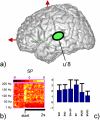A blueprint for real-time functional mapping via human intracranial recordings
- PMID: 17971857
- PMCID: PMC2040217
- DOI: 10.1371/journal.pone.0001094
A blueprint for real-time functional mapping via human intracranial recordings
Abstract
Background: The surgical treatment of patients with intractable epilepsy is preceded by a pre-surgical evaluation period during which intracranial EEG recordings are performed to identify the epileptogenic network and provide a functional map of eloquent cerebral areas that need to be spared to minimize the risk of post-operative deficits. A growing body of research based on such invasive recordings indicates that cortical oscillations at various frequencies, especially in the gamma range (40 to 150 Hz), can provide efficient markers of task-related neural network activity.
Principal findings: Here we introduce a novel real-time investigation framework for mapping human brain functions based on online visualization of the spectral power of the ongoing intracranial activity. The results obtained with the first two implanted epilepsy patients who used the proposed online system illustrate its feasibility and utility both for clinical applications, as a complementary tool to electrical stimulation for presurgical mapping purposes, and for basic research, as an exploratory tool used to detect correlations between behavior and oscillatory power modulations. Furthermore, our findings suggest a putative role for high gamma oscillations in higher-order auditory processing involved in speech and music perception.
Conclusion/significance: The proposed real-time setup is a promising tool for presurgical mapping, the investigation of functional brain dynamics, and possibly for neurofeedback training and brain computer interfaces.
Conflict of interest statement
Figures





Similar articles
-
Recording human electrocorticographic (ECoG) signals for neuroscientific research and real-time functional cortical mapping.J Vis Exp. 2012 Jun 26;(64):3993. doi: 10.3791/3993. J Vis Exp. 2012. PMID: 22782131 Free PMC article.
-
Real-time functional mapping with electrocorticography in pediatric epilepsy: comparison with fMRI and ESM findings.Clin EEG Neurosci. 2014 Jul;45(3):205-11. doi: 10.1177/1550059413492960. Clin EEG Neurosci. 2014. PMID: 24293161 Free PMC article.
-
Four-dimensional functional cortical maps of visual and auditory language: Intracranial recording.Epilepsia. 2019 Feb;60(2):255-267. doi: 10.1111/epi.14648. Epub 2019 Feb 1. Epilepsia. 2019. PMID: 30710356 Free PMC article.
-
High-frequency gamma oscillations and human brain mapping with electrocorticography.Prog Brain Res. 2006;159:275-95. doi: 10.1016/S0079-6123(06)59019-3. Prog Brain Res. 2006. PMID: 17071238 Review.
-
Task-related gamma-band dynamics from an intracerebral perspective: review and implications for surface EEG and MEG.Hum Brain Mapp. 2009 Jun;30(6):1758-71. doi: 10.1002/hbm.20750. Hum Brain Mapp. 2009. PMID: 19343801 Free PMC article. Review.
Cited by
-
From Mimicry to Language: A Neuroanatomically Based Evolutionary Model of the Emergence of Vocal Language.Front Neurosci. 2016 Jun 30;10:307. doi: 10.3389/fnins.2016.00307. eCollection 2016. Front Neurosci. 2016. PMID: 27445676 Free PMC article.
-
Fast presurgical functional mapping using task-related intracranial high gamma activity.J Neurosurg. 2013 Jul;119(1):26-36. doi: 10.3171/2013.2.JNS12843. Epub 2013 Apr 19. J Neurosurg. 2013. PMID: 23600935 Free PMC article. Clinical Trial.
-
FMRI and intra-cranial electrocorticography recordings in the same human subjects reveals negative BOLD signal coupled with silenced neuronal activity.Brain Struct Funct. 2022 May;227(4):1371-1384. doi: 10.1007/s00429-021-02342-4. Epub 2021 Aug 7. Brain Struct Funct. 2022. PMID: 34363092 Free PMC article.
-
Cortical subnetwork dynamics during human language tasks.Neuroimage. 2016 Jul 15;135:261-72. doi: 10.1016/j.neuroimage.2016.03.072. Epub 2016 Apr 2. Neuroimage. 2016. PMID: 27046113 Free PMC article.
-
Advances in human intracranial electroencephalography research, guidelines and good practices.Neuroimage. 2022 Oct 15;260:119438. doi: 10.1016/j.neuroimage.2022.119438. Epub 2022 Jul 2. Neuroimage. 2022. PMID: 35792291 Free PMC article. Review.
References
-
- Lesser R, Gordon B, Uematsu S. Electrical stimulation and language. J Clin Neurophysiol. 1994;11:191–204. - PubMed
-
- Lesser RP, Arroyo S, Crone N, Gordon B. Motor and sensory mapping of the frontal and occipital lobes. Epilepsia. 1998;39(Suppl 4):S69–80. - PubMed
-
- Lesser RP, Luders H, Klem G, Dinner DS, Morris HH, et al. Extraoperative cortical functional localization in patients with epilepsy. J Clin Neurophysiol. 1987;4:27–53. - PubMed
-
- Ojemann G, Ojemann J, Lettich E, Berger M. Cortical language localization in left, dominant hemisphere. An electrical stimulation mapping investigation in 117 patients. J Neurosurg. 1989;71:316–326. - PubMed
-
- Kahane P, Minotti L, Hoffmann D, Lachaux J, Ryvlin P. Invasive EEG in the definition of the seizure onset zone: depth electrodes. In: Rosenow F, Lüders HO, editors. Handbook of Clinical Neurophysiology Pre-surgical assessment of the epilepsies with clinical neurophysiology and functional neuroimaging: Elsevier Science. 2004.
Publication types
MeSH terms
LinkOut - more resources
Full Text Sources
Other Literature Sources
Medical

